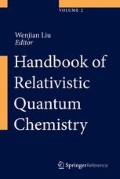Abstract
It is shown that relativistic many-body Hamiltonians and wave functions can be expressed systematically with Tracy-Singh products for partitioned matrices. The latter gives rise to the usual notion for a relativistic N-electron wave function: a column vector composed of 2N blocks, each of which consists of 2N components formed by the Kronecker products of N one-electron 2-spinors. Yet, the noncommutativity of the Tracy-Singh product dictates that the chosen serial ordering of electronic coordinates cannot be altered when antisymmetrizing a Tracy-Singh product of 4-spinors. It is further shown that such algebraic representation uncovers readily the internal symmetries of the relativistic Hamiltonians and wave functions, which are crucial for deriving the electron-electron coalescence conditions.
Access this chapter
Tax calculation will be finalised at checkout
Purchases are for personal use only
References
Dirac PAM (1928) The quantum theory of the electron. Proc R Soc Lond A 117:610
Liu W (2012) Perspectives of relativistic quantum chemistry: the negative energy cat smiles. Phys Chem Chem Phys 14:35
Liu W, Lindgren I (2013) Going beyond “no-pair relativistic quantum chemistry”. J Chem Phys 139:014108
Liu W (2014) Advances in relativistic molecular quantum mechanics. Phys Rep 537:59
Li Z, Shao S, Liu W (2012) Relativistic explicit correlation: coalescence conditions and practical suggestions. J Chem Phys 136:144117
Kato T (1957) On the eigenfunctions of many-particle systems in quantum mechanics. Commun Pure Appl Math 10:151
Kutzelnigg W (1984) Basis set expansion of the Dirac operator without variational collapse. Int J Quantum Chem 25:107
Lewin M, Séré E (2010) Spectral pollution and how to avoid it. Proc Lond Math Soc 100:864
Lin L, Shao S, E W (2013) Efficient iterative method for solving the Dirac-Kohn-Sham density functional theory. J Comput Phys 245:205
Thaller B (1992) The Dirac equation. Springer, Berlin
Dereziński J (2012) Open problems about many-body Dirac operators. IAMP News Bull Jan 2012:11
Tracy DS, Singh RP (1972) A new matrix product and its applications in partitioned matrix differentiation. Stat Neerl 26:143
Liu S (1999) Matrix results on the Khatri-Rao and Tracy-Singh products. Linear Algebra Appl 289:267
Acknowledgements
The research of this work was supported by grants from the National Natural Science Foundation of China (Project Nos. 21033001, 21273011, 21290192, and 11471025).
Author information
Authors and Affiliations
Corresponding authors
Editor information
Editors and Affiliations
Rights and permissions
Copyright information
© 2017 Springer-Verlag Berlin Heidelberg
About this entry
Cite this entry
Shao, S., Li, Z., Liu, W. (2017). Basic Structures of RelativisticWave Functions. In: Liu, W. (eds) Handbook of Relativistic Quantum Chemistry. Springer, Berlin, Heidelberg. https://doi.org/10.1007/978-3-642-40766-6_7
Download citation
DOI: https://doi.org/10.1007/978-3-642-40766-6_7
Published:
Publisher Name: Springer, Berlin, Heidelberg
Print ISBN: 978-3-642-40765-9
Online ISBN: 978-3-642-40766-6
eBook Packages: Chemistry and Materials ScienceReference Module Physical and Materials ScienceReference Module Chemistry, Materials and Physics

